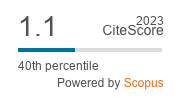Malaysian Journal of Mathematical Sciences, March 2025, Vol. 19, No. 1
The Modeling and Numerical Solution of Branch Retinal Artery Occlusion
Fatahillah, A., Widodo, B., and Roslan, R.
Corresponding Email: [email protected]
Received date: 3 January 2024
Accepted date: 17 September 2024
Abstract:
The diameter of an artery can narrow due to blood clots or accumulations of cholesterol obstructing blood flow in one or more retinal arteries, leading to the occurrence of Retinal Artery Occlusion (RAO) and painless vision loss. This study introduces a mathematical model to analyze blood flow in Branch Retinal Artery Occlusion (BRAO). Built using the Finite Volume Method (FVM), the model included variability in its geometric (thickness and length of constriction) and three-dimensional topological structures. The model was developed using the QUICK method and simulated to determine the effect of stenosis and initial flow velocity on the emergence of eye stroke with the aid of MATLAB. This simulation documented the magnitude of velocity and pressure for various forms of stenosis to analyze the causes of eye stroke. Computational Fluid Dynamics was employed to simulate turbulent flow in BRAO using ANSYS FLUENT. The results show that $90\%$ thickness clot in a branch of the retinal artery can be extremely dangerous because the flow rate and pressure exceed normal limits. With the increased severity of stenosis, the pressure and wall shear stress at the stenosis region also increase, eventually and the high-speed flow rate formed at the stenosed region begins to dominate the flow. The conclusion of present study is relevant to the investigation of disease arteries and has contributed to a more fine-cut understanding of the impact of BRAO on eye stroke.
Keywords: modelling; finite volume method; branch retinal artery occlusion









